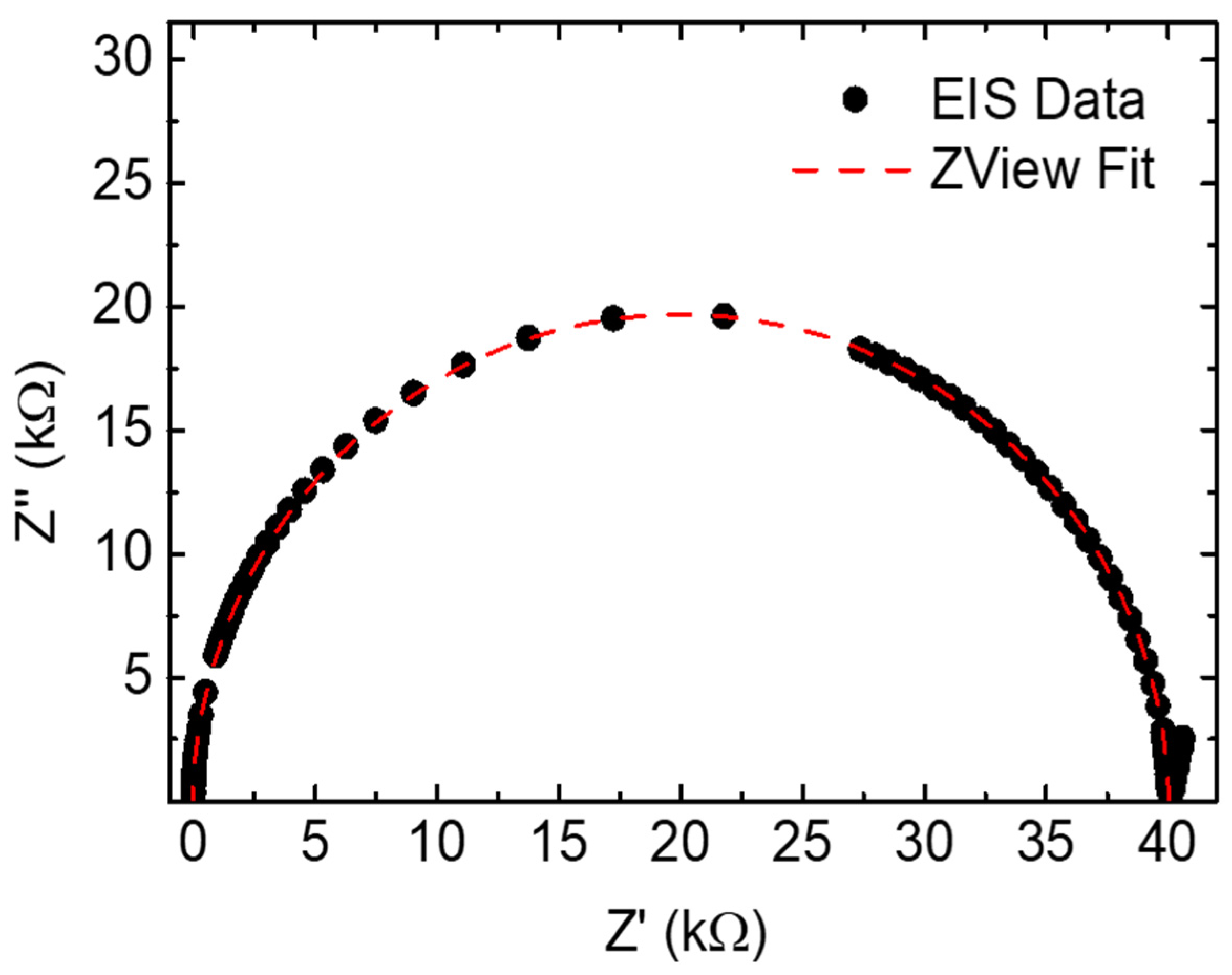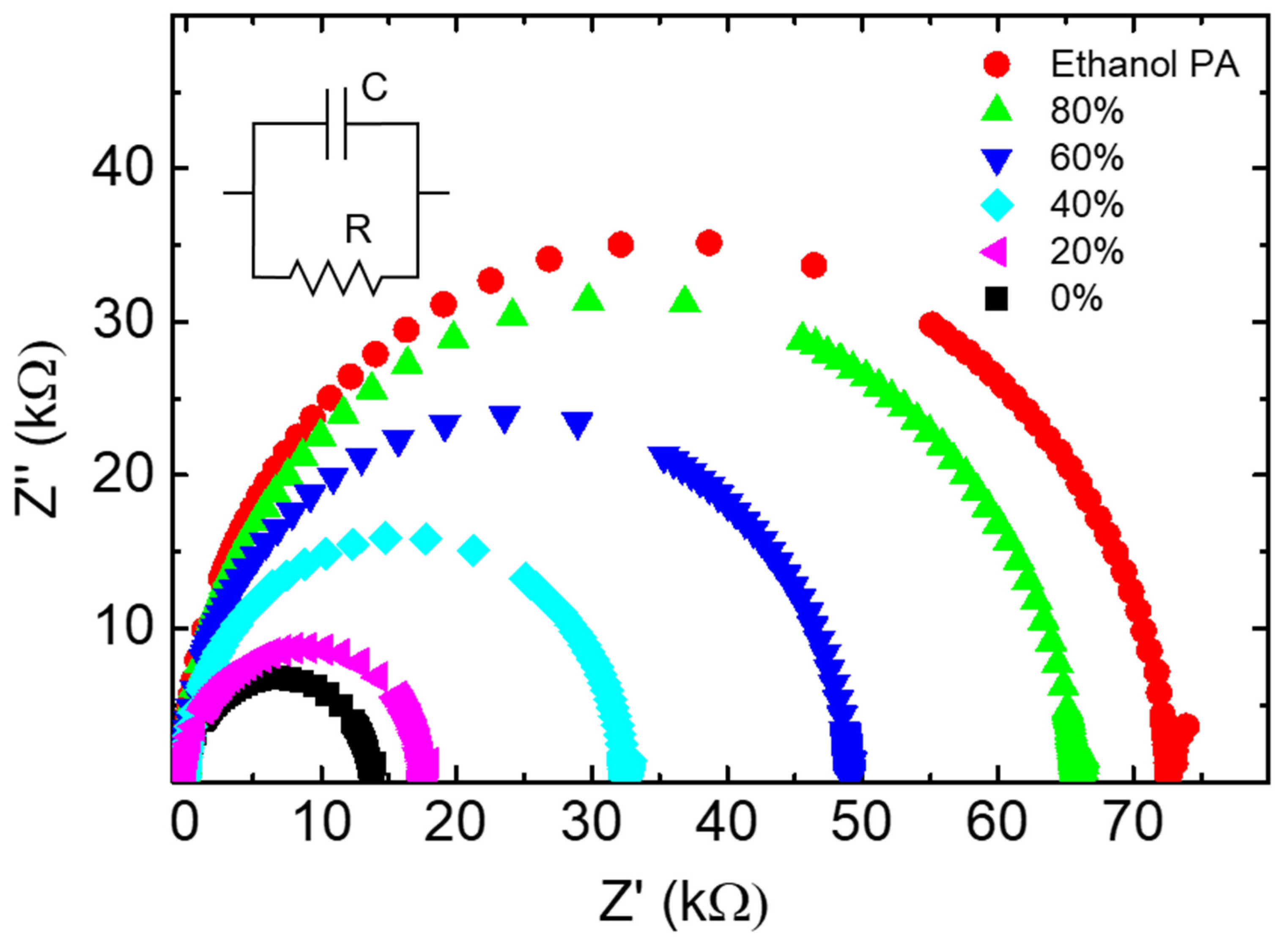Miniaturized 3D-Printed Cell Enables Water/Ethanol Quantification Using Electrochemical Impedance Spectroscopy
Abstract
:1. Introduction
2. Materials and Methods
2.1. Three-Dimensional-Printed System
2.2. Electrochemical Measurements
3. Results and Discussion
4. Conclusions
Author Contributions
Funding
Data Availability Statement
Acknowledgments
Conflicts of Interest
References
- Akram, F.; ul Haq, I.; Raja, S.I.; Mir, A.S.; Qureshi, S.S.; Aqeel, A.; Shah, F.I. Current Trends in Biodiesel Production Technologies and Future Progressions: A Possible Displacement of the Petro-Diesel. J. Clean. Prod. 2022, 370, 133479. [Google Scholar] [CrossRef]
- Bull, S.R. Renewable Alternative Fuels: Alcohol Production from Lignocellulosic Biomass. Renew. Energy 1994, 5, 799–806. [Google Scholar] [CrossRef]
- Passos, W.E.; Oliveira, I.P.; Michels, F.S.; Trindade, M.A.G.; Falcão, E.A.; Marangoni, B.S.; Oliveira, S.L.; Caires, A.R.L. Quantification of Water in Bioethanol Using Rhodamine B as an Efficient Molecular Optical Probe. Renew. Energy 2021, 165, 42–51. [Google Scholar] [CrossRef]
- Produção de Cana-de-Açúcar Cresce 4,4% e Pode Chegar a 598,3 Milhões de Toneladas Na Safra 2022/23. Available online: https://www.gov.br/agricultura/pt-br/assuntos/noticias/producao-de-cana-de-acucar-cresce-4-4-e-pode-chegar-a-598-3-milhoes-de-toneladas-na-safra-2022-23 (accessed on 18 April 2023).
- Fuel Ethanol Production in Major Countries 2022. Available online: https://www.statista.com/statistics/281606/ethanol-production-in-selected-countries/ (accessed on 18 April 2023).
- Etanol. Available online: https://www.gov.br/anp/pt-br/assuntos/producao-e-fornecimento-de-biocombustiveis/etanol/apresentacao (accessed on 13 April 2023).
- Resolução 907 2022 Da ANP—Agência Nacional Do Petróleo, Gás Natural e Biocombustíveis BR. Available online: https://atosoficiais.com.br/anp/resolucao-n-907-2022-dispoe-sobre-as-especificacoes-do-etanol-combustivel-e-suas-regras-de-comercializacao-em-todo-o-territorio-nacional?origin=instituicao (accessed on 13 April 2023).
- Ribeiro, M.S.; Angnes, L.; Rocha, F.R.P. A Simple and Fast Procedure for in Situ Determination of Water in Ethanol Fuel. J. Braz. Chem. Soc. 2013, 24, 418–422. [Google Scholar] [CrossRef]
- Bueno, L.; Paixão, T.R.L.C. A Copper Interdigitated Electrode and Chemometrical Tools Used for the Discrimination of the Adulteration of Ethanol Fuel with Water. Talanta 2011, 87, 210–215. [Google Scholar] [CrossRef]
- Vesnin, V.L. Analysis of the Composition of Water–Alcohol Mixtures Using the Infrared Absorption Spectra of Their Vapor. J. Appl. Spectrosc. 2022, 88, 1202–1209. [Google Scholar] [CrossRef]
- de Queiroz, D.P.; Florentino, A.D.O.; Bruno, J.C.; da Silva, J.H.D.; Riul, A.; Giacometti, J.A. The Use of an E-Tongue for Discriminating Ethanol/Water Mixtures and Determination of Their Water Content. Sens. Actuators B Chem. 2016, 230, 566–570. [Google Scholar] [CrossRef]
- Souza, A.C.; Aristone, F.; Capitanio, R.A.; de Paula, M.H. Quantification of Water Content in Water–Ethanol Solutions Using Photothermal Transparent Transducer Method. Sens. Actuators B Chem. 2016, 226, 495–499. [Google Scholar] [CrossRef]
- Omido, C.R.; Oliveira, S.L.; Lima, J.R.; Magalhães, K.F.; de Carvalho, A.A.; Kitano, C. Water Content in Hydrated Ethanol Fuel Measured by a Photothermal Chamber with a Transparent Transducer. Fuel 2015, 157, 122–125. [Google Scholar] [CrossRef]
- Omido, C.R.; Oliveira, S.L.; Shiraishi, R.S.; Magalhães, K.F.; Ferreira, V.S.; de Carvalho, A.A.; Kitano, C.; de Paula, M.H. Quantification of Water in Ethanol Using a Photothermal Transparent Transducer. Sens. Actuators B Chem. 2013, 178, 581–585. [Google Scholar] [CrossRef]
- Bernardi, A.; Borges Da Silva, L.E.; Veloso, G.F.C.; Filho, J.A.F. Characterization of the Ethanol-Water Blend by Acoustic Signature Analysis in Ultrasonic Signals. IEEE Access 2022, 10, 6580–6591. [Google Scholar] [CrossRef]
- Li, G.; Wang, S.; Duan, Y.Y. Towards Conductive-Gel-Free Electrodes: Understanding the Wet Electrode, Semi-Dry Electrode and Dry Electrode-Skin Interface Impedance Using Electrochemical Impedance Spectroscopy Fitting. Sens. Actuators B Chem. 2018, 277, 250–260. [Google Scholar] [CrossRef]
- Lamellar α-Zirconium Phosphate Nanoparticles Supported on N-Doped Graphene Nanosheets as Electrocatalysts for the Detection of Levofloxacin. Available online: https://pubs.acs.org/doi/epdf/10.1021/acsanm.3c03162 (accessed on 17 October 2023).
- Jiao, S.; Li, T.; Xiong, C.; Tang, C.; Dang, A.; Li, H.; Zhao, T. A Facile Method of Preparing the Asymmetric Supercapacitor with Two Electrodes Assembled on a Sheet of Filter Paper. Nanomaterials 2019, 9, 1338. [Google Scholar] [CrossRef] [PubMed]
- Venezia, E.; Salimi, P.; Liang, S.; Fugattini, S.; Carbone, L.; Zaccaria, R.P. Comparative Study of Lithium Halide-Based Electrolytes for Application in Lithium-Sulfur Batteries. Inorganics 2023, 11, 86. [Google Scholar] [CrossRef]
- De Souza, J.E.; Scherer, M.D.; Cáceres, J.A.S.; Caires, A.R.L.; M’Peko, J.-C. A Close Dielectric Spectroscopic Analysis of Diesel/Biodiesel Blends and Potential Dielectric Approaches for Biodiesel Content Assessment. Fuel 2013, 105, 705–710. [Google Scholar] [CrossRef]
- M’Peko, J.-C.; Reis, D.L.S.; De Souza, J.E.; Caires, A.R.L. Evaluation of the Dielectric Properties of Biodiesel Fuels Produced from Different Vegetable Oil Feedstocks through Electrochemical Impedance Spectroscopy. Int. J. Hydrogen Energy 2013, 38, 9355–9359. [Google Scholar] [CrossRef]
- Biernat, K.; Bocian, P.; Bukrejewski, P.; Noworyta, K.R. Application of the Impedance Spectroscopy as a New Tool for Studying Biodiesel Fuel Aging Processes. Energies 2019, 12, 738. [Google Scholar] [CrossRef]
- Baena, L.M.; Vásquez, F.A.; Calderón, J.A. Corrosion Assessment of Metals in Bioethanol-Gasoline Blends Using Electrochemical Impedance Spectroscopy. Heliyon 2021, 7, e07585. [Google Scholar] [CrossRef]
- Leo, A.; Monteduro, A.G.; Rizzato, S.; Milone, A.; Maruccio, G. Miniaturized Sensors for Detection of Ethanol in Water Based on Electrical Impedance Spectroscopy and Resonant Perturbation Method—A Comparative Study. Sensors 2022, 22, 2742. [Google Scholar] [CrossRef]
- Bhattacharjee, N.; Urrios, A.; Kang, S.; Folch, A. The Upcoming 3D-Printing Revolution in Microfluidics. Lab Chip 2016, 16, 1720–1742. [Google Scholar] [CrossRef]
- Guima, K.-E.; Alencar, L.M.; da Silva, G.C.; Trindade, M.A.G.; Martins, C.A. 3D-Printed Electrolyzer for the Conversion of Glycerol into Tartronate on Pd Nanocubes. ACS Sustain. Chem. Eng. 2018, 6, 1202–1207. [Google Scholar] [CrossRef]
- Guima, K.-E.; Souza, V.; Martins, C. Insulating 3D-Printed Templates Are Turned into Metallic Electrodes: Application as Electrodes for Glycerol Electrooxidation. RSC Adv. 2019, 9, 15158–15161. [Google Scholar] [CrossRef] [PubMed]
- Estadulho, G.; Alencar, L.; Guima, K.-E.; Trindade, M.; Martins, C. 3D-Printed Templates Converted into Graphite, Ruthenium, or Copper Are Used as Monolithic Sensors. ACS Appl. Electron. Mater. 2021, 3, 3482–3488. [Google Scholar] [CrossRef]
- de Souza, M.B.C.; Guima, K.-E.; Fernández, P.S.; Martins, C.A. Glycerol Is Converted into Energy and Carbonyl Compounds in a 3D-Printed Microfluidic Fuel Cell: In Situ and In Operando Bi-Modified Pt Anodes. ACS Appl. Mater. Interfaces 2022, 14, 25457–25465. [Google Scholar] [CrossRef]
- Guima, K.-E.; Coelho, P.-H.L.; Trindade, M.A.G.; Martins, C.A. 3D-Printed Glycerol Microfluidic Fuel Cell. Lab Chip 2020, 20, 2057–2061. [Google Scholar] [CrossRef] [PubMed]





| Ethanol Content (%) | Parameters | |||||
|---|---|---|---|---|---|---|
| Ethanol PA | Ethanol Fuel | |||||
| R (kΩ) | C (10−11 F) | εr | R (kΩ) | C (10−11 F) | εr | |
| 0 | 13.307 | 7.187 | 83.143 | 10.580 | 7.641 | 88.392 |
| 10 | 15.905 | 6.718 | 77.714 | 13.678 | 7.377 | 85.341 |
| 20 | 18.917 | 6.208 | 71.818 | 17.968 | 6.887 | 79.668 |
| 30 | 25.836 | 5.653 | 65.393 | 32.248 | 6.201 | 71.728 |
| 40 | 29.449 | 5.122 | 59.246 | 34.476 | 5.681 | 65.720 |
| 50 | 39.751 | 4.399 | 50.883 | 38.339 | 5.236 | 60.573 |
| 60 | 48.534 | 3.858 | 44.633 | 43.371 | 4.733 | 54.747 |
| 70 | 58.689 | 3.349 | 38.741 | 40.732 | 4.204 | 48.628 |
| 80 | 66.018 | 3.062 | 35.425 | 41.448 | 3.678 | 42.541 |
| 90 | 71.657 | 2.691 | 31.127 | 46.321 | 3.104 | 35.909 |
| 91 | 73.139 | 2.751 | 31.829 | 44.617 | 3.105 | 35.923 |
| 92 | 68.250 | 2.674 | 30.927 | 46.736 | 3.029 | 35.041 |
| 93 | 75.371 | 2.659 | 30.759 | 49.316 | 2.951 | 34.137 |
| 94 | 66.519 | 2.661 | 30.786 | 50.594 | 2.898 | 33.526 |
| 95 | 71.872 | 2.501 | 28.933 | 50.792 | 2.838 | 32.830 |
| 96 | 78.086 | 2.513 | 29.069 | - | - | - |
| 97 | 79.996 | 2.447 | 28.311 | - | - | - |
| 98 | 78.810 | 2.379 | 27.525 | - | - | - |
| 99 | 77.629 | 2.331 | 26.969 | - | - | - |
| 99.5 | 71.753 | 2.375 | 27.471 | - | - | - |
| Gas Station | Dielectric Constant ± 0.30 | EIS Ethanol Content (%) ± 0.30 | Digital Densimeter Ethanol Content (%) ± 0.16 |
|---|---|---|---|
| A | 33.12 | 95.08 | 95.26 |
| B | 32.94 | 95.38 | 95.24 |
| C | 32.50 | 96.09 | 95.31 |
| D | 32.73 | 95.72 | 95.23 |
Disclaimer/Publisher’s Note: The statements, opinions and data contained in all publications are solely those of the individual author(s) and contributor(s) and not of MDPI and/or the editor(s). MDPI and/or the editor(s) disclaim responsibility for any injury to people or property resulting from any ideas, methods, instructions or products referred to in the content. |
© 2023 by the authors. Licensee MDPI, Basel, Switzerland. This article is an open access article distributed under the terms and conditions of the Creative Commons Attribution (CC BY) license (https://creativecommons.org/licenses/by/4.0/).
Share and Cite
Paixao, P.A.; Michels, F.S.; Oliveira, S.L.; Goncalves, A.-M.B.; Martins, C.A.; Caires, A.R.L.; Alves, D.C.B. Miniaturized 3D-Printed Cell Enables Water/Ethanol Quantification Using Electrochemical Impedance Spectroscopy. Sensors 2024, 24, 131. https://doi.org/10.3390/s24010131
Paixao PA, Michels FS, Oliveira SL, Goncalves A-MB, Martins CA, Caires ARL, Alves DCB. Miniaturized 3D-Printed Cell Enables Water/Ethanol Quantification Using Electrochemical Impedance Spectroscopy. Sensors. 2024; 24(1):131. https://doi.org/10.3390/s24010131
Chicago/Turabian StylePaixao, Pablo A., Flávio S. Michels, Samuel L. Oliveira, Alem-Mar B. Goncalves, Cauê A. Martins, Anderson R. L. Caires, and Diego C. B. Alves. 2024. "Miniaturized 3D-Printed Cell Enables Water/Ethanol Quantification Using Electrochemical Impedance Spectroscopy" Sensors 24, no. 1: 131. https://doi.org/10.3390/s24010131
APA StylePaixao, P. A., Michels, F. S., Oliveira, S. L., Goncalves, A.-M. B., Martins, C. A., Caires, A. R. L., & Alves, D. C. B. (2024). Miniaturized 3D-Printed Cell Enables Water/Ethanol Quantification Using Electrochemical Impedance Spectroscopy. Sensors, 24(1), 131. https://doi.org/10.3390/s24010131









